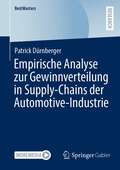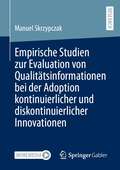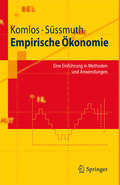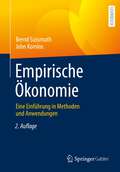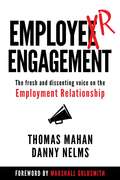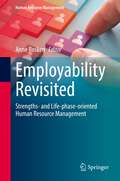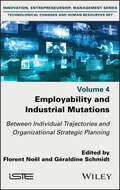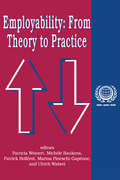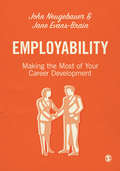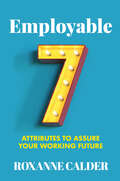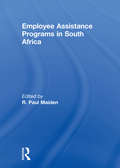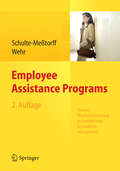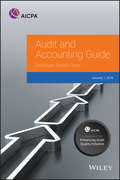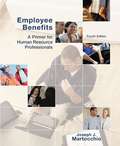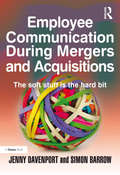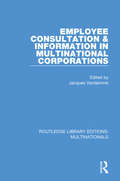- Table View
- List View
Empirische Analyse zur Gewinnverteilung in Supply-Chains der Automotive-Industrie (BestMasters)
by Patrick DürnbergerIn diesem Buch werden Ergebnisse einer Erfolgsanalyse von Unternehmen der Automotive-Supply-Chain mit den Expert*innenaussagen zum Thema Open-Book-Politik und Finanzdatentransparenz verknüpft. Es wird gezeigt, welche Teilnehmer entlang der Automotive-Lieferkette erfolgreicher sind und ob es einen Zusammenhang mit der Offenlegung von sensiblen Unternehmensdaten gibt. Dafür werden insgesamt 15 Expert*inneninterviews mit Rohstoff- und Teilelieferanten, Modul- und Systemlieferanten, Fahrzeugherstellern und Händlern durchgeführt und durch Geschäftsberichtanalysen mit Rohstoff- und Teilelieferanten, Modul- und Systemlieferanten sowie Fahrzeugherstellern ergänzt. Resultat sind Erkenntnisse über die Gewinnverteilungsstruktur in der Automotive-Lieferkette sowie Aussagen über Chancen und Risiken der Implementierung von Open-Book-Policy beziehungsweise Finanzdatentransparenz entlang der Lieferkette. Abschließend werden Handlungsempfehlungen vorgestellt, um Personen, die in ihrem beruflichen Umfeld mit ähnlichen Projekten zu tun haben, eine Hilfestellung zu bieten.
Empirische Forschung in den Wirtschafts- und Sozialwissenschaften klipp & klar (WiWi klipp & klar)
by Hariet KöstnerDieses Buch vermittelt das erforderliche Hintergrundwissen, das für die erfolgreiche Umsetzung eines empirischen Projektes nötig ist. Neben der grundsätzlichen Diskussion über das Wesen empirischer Forschung werden alle Phasen, die ein Projekt typischerweise durchläuft, abgehandelt: Besonderheiten unterschiedlicher Erhebungsmethoden, eine anwendungsorientierte Darstellung der Stichprobentheorie sowie die umsetzungsorientierte Gestaltung von Fragebögen. Der zweite Teil legt den Fokus auf die statistische Datenanalyse, ohne sich in Formeln zu verlieren. Praktische Umsetzung und Interpretation nehmen diesem – teils gefürchteten – Teil der empirischen Arbeit den Schrecken und machen die Notwendigkeit solider statistischer Analyse deutlich. Die Interpretation erfolgt überwiegend anhand von Outputs, die mit dem Auswertungsprogramm SPSS erzeugt wurden. Im Vordergrund steht aber nicht die technische Durchführung, sondern der kompetente Umgang mit den Ergebnissen. Ob diese mit SPSS oder einem der vielen anderen statistischen Auswertungsprogramme erzeugt werden, ist letztlich nachrangig. Entscheidend ist die Fähigkeit, die Ergebnisse richtig zu interpretieren und darauf aufbauend praxisrelevante Ableitungen zu entwickeln, um das Projekt zu einem erfolgreichen Abschluss zu bringen.Durch die anwendungsorientierte Gestaltung der Fallbeispiele, die sich durch das gesamte Buch ziehen, wird das Verständnis und die Übertragung auf eigene Fragestellungen erleichtert. Reflektionen über ethisch-moralische Aspekte der empirischen Forschung – Stichwort Datenschutz – regen zum kritischen Hinterfragen eigener Projekte an.
Empirische Studien zur Evaluation von Qualitätsinformationen bei der Adoption kontinuierlicher und diskontinuierlicher Innovationen
by Manuel SkrzypczakManuel Skrzypczak untersucht im Rahmen zweier empirischer Studien, wie sich eine variierende Produktinnovativität auf die Produktevaluation auswirkt. Eine erste Studie geht mittels zweier Experimente der Frage nach, welche Qualitätsinformationen bei der Evaluation kontinuierlicher Innovationen die Qualitätsbeurteilung und Kaufintention dominieren. Eine zweite Studie untersucht unter besonderer Berücksichtigung emotionaler und kognitiver Informationsverarbeitungsprozesse mittels eines deduktiven Textanalyseverfahrens anhand von online Produktrezensionen, wie sich der Qualitätsbeurteilungsprozess zwischen diskontinuierlichen und kontinuierlichen Innovationen unterscheidet. Beide Studien liefern Implikationen für Praktiker und Forscher, indem die relative Wirkung und Verarbeitung von Qualitätsinformationen innerhalb des Produktevaluationsprozesses in Abhängigkeit der Produktinnovativität evaluiert wird.
Empirische Ökonomie
by Bernd Süssmuth John KomlosDas Buch führt anhand einfacher und zugleich origineller Anwendungen aus Gebieten wie Wirtschaftsgeschichte, Humankapitaltheorie oder Biologie in die Methoden der klassischen Ökonometrie ein. Da auch grundlegende Konzepte der beschreibenden und schließenden Statistik behandelt werden, sind keine Vorkenntnisse nötig. Damit stellt sich das Buch der Aufgabe, den Studierenden neben den methodischen Fertigkeiten auch Anregung und Motivation zu eigenständigem empirischen Arbeiten zu geben.
Empirische Ökonomie: Eine Einführung in Methoden und Anwendungen (Springer-lehrbuch Ser.)
by Bernd Süssmuth John KomlosDas Buch liefert eine anwendungsorientierte Einführung in ökonometrische Methoden. Anhand einfacher, aber origineller Anwendungen aus verschiedenen Gebieten wie Wirtschaftsgeschichte, Humankapitaltheorie oder Biologie werden die Methoden der klassischen Ökonometrie erklärt und veranschaulicht. Auf diese Art und Weise werden nicht nur methodische Fertigkeiten vermittelt, sondern Studierende zum eigenständigen empirischen Arbeiten motiviert. Fachkenntnisse werden nicht vorausgesetzt. Die 2. Auflage wurde um ein zusätzliches Kapitel ergänzt.
EmployER Engagement: The Fresh and Dissenting Voice on the Employment Relationship
by Thomas Mahan NelmsThe signs of discontent are all there, yet they are ignored. Workplaces are suffering from unnecessary turnover, unfilled positions, lost customers, overworked staff, and compromised profit. Taking the guesswork out of engagement and retention, EmployER Engagement is the fresh and dissenting voice on the employment relationship.You&’ve heard it too many times: &“I&’ve got to update my résumé.&” &“I can&’t work for that jerk anymore.&” &“I&’m sick of having that carrot dangling in my face.&” &“This is a dead-end job; I&’m out.&” It happens every day. The signs of discontent are all there, yet they are ignored. Workplaces are suffering from unnecessary turnover, unfilled positions, lost customers, overworked staff, and compromised profit. Employee morale is flat, clever but empty perks continue to fail, and everyone knows that employee engagement scores are a joke. Poaching is the new best practice, and employees are bailing. Like it or not, employees have control in this high-stakes, employee-in-control market. And this employee market will continue for some time. It&’s simple demographic science. US workers will hold the hammer for years to come. Here&’s the deal, employer: There are plenty of people to do all the work that needs to be done; they&’re just working somewhere else. Employees don&’t need you; you need them. So how can you recruit the best employees and keep them working for you? The answer is clear: companies CAN and MUST become better employers. Taking the guesswork out of engagement and retention, EmployER Engagement is the fresh and dissenting voice on the employment relationship.
Employability Revisited: Strengths- and Life-phase-oriented Human Resource Management (Human Resource Management)
by Anne RoskenOne of the most pressing issues in current and future human resource management is the inclusion of strengths and life stages within human resource structures. This book examines in a multi-perspective, innovative and participatory way the conditioning factors for persistent stereotyping processes in the context of age and work. Levers for change as well as the circular model for optimizing or implementing life-phase oriented human resource management are presented. The book is valuable for lecturers and students with a focus on corporate and human resources management. It also offers practical assistance for corporate leaders and human resources managers for the implementation of a strength-oriented human resources management.
Employability and Industrial Mutations: Between Individual Trajectories and Organizational Strategic Planning
by Géraldine Schmidt Florent NoëlIndustrial, economic and organizational mutations are creating a transformation in employment, skills and work. Developing the employability of the workforce is one response to these challenges. However, the link between mutations and employability is not obvious: it must be constructed and implemented in order to ensure that employees are able to reach satisfying professional situations.Employability and Industrial Mutations presents a definition of employability and the associated challenges for public authorities, organizations and employees: managing unemployment, successful change and employee empowerment. It then examines several worker profiles to better understand what “being employable” means. It goes on to analyze several examples of management systems for employability at different stages of an individual’s career, and finally explores the issue of developing or maintaining employability in real-life situations and contexts.This book brings together researchers and practitioners from a range of different fields in order to shed light on the complex relationship between mutations and employability.
Employability and Skills Handbook for Tourism, Hospitality and Events Students
by Miriam FirthThis handbook provides students with an essential understanding of the skills and knowledge needed to work in the tourism, hospitality and events industries. It offers reflective, reflexive and critical analysis on personal, academic and professional development. Not only looking at how to develop the skills, attributes and prospects for employment in these competitive industries, this handbook also focuses on what the employers in tourism, hospitality and events sectors require of graduate employees. Highly illustrated, the chapters contain think points and activities, and case studies are integrated throughout offering first hand advice from both employer and graduate perspectives. The first book to focus on skills and employability in tourism, hospitality and events, this is a must read for all students studying these fields.
Employability via Higher Education: Sustainability as Scholarship
by Alice DiverThis book discusses the topic of graduate employability from the premise that in this era of ‘massification,’ economic austerity, and political uncertainties, higher education (HE) no longer guarantees a clear ‘work place advantage.’ Divided into three sections, the book offers theoretical and philosophical discourses on the ‘HE quandary,’ whilst taking into account – and critiquing - political, temporal, and national contexts. It culminates in an investigation into specific discipline areas. It offers insights into the way that institutions, decision-makers, academics, and professional support staff can work together towards ensuring that our graduates are able to cope with the varied demands and challenges of modern job markets. It harnesses arguments and reflections on the breadth and depth of the functions of HE, such as social transformation, promoting principles of social justice, and providing opportunities. It grounds these in a triadic model for enhancing student engagement and holistic learning, namely, the emotional, cognitive, and behavioural aspects. As an anthology, it is forward-gazing in terms of the sustainability debate, whilst still offering evidence-based, research-grounded, practical suggestions to readers looking for tips and tools of the trade.
Employability: From Theory to Practice
by Michele BaukensIn the struggle against unemployment and marginalization, employability has become the one major tool to counteract this phenomenon. Those who have no chances to develop or enhance their employability will fail in the competitive labor market of the new economic order. While the notion of employability is not exactly new, the weight now being placed upon it is new: to equip job seekers for the far-reaching changes currently taking place in the economy and the world of work. What is at stake? Is employability an instrument for the regulation of the labor market, distinguishing between the employable and the unemployable? Or is it a set of measures to facilitate the insertion or reinsertion of workers into the workforce? Is employability in the future the defining policy framework for labor market policies? What are the consequences of such a development for policy makers? Employability: From Theory to Practice addresses these questions. Its internationally renowned authors provide a valuable contribution to the conceptual and operational content of the notion of employability. The form and content of measures of employability vary by state, but represent a general trend. Part 1 deals with the concepts and instruments of employability. Part 2 evaluates measures implemented in a number of countries to improve employability of job-seekers. The countries involved are the UK, the Netherlands, Belgium, Ireland, New Zealand, Poland, and Slovakia. Part 3 showcases a practical approach with Canada, which in 1996-97 moved from an unemployment to an employment insurance. This volume shows both the possibilities and limitations of measures to promote employability. It helps clarify complex policy questions which will contribute to a better understanding of the concept for policy makers and administrators. It will help policy makers, professionals, and scholars assess current trends in the workplace.
Employability: Making the Most of Your Career Development (Sage Study Skills Ser.)
by John Neugebauer Jane Evans-BrainKeen to succeed in today's competitive job market? Want to learn how to make the most of longer-term graduate career development opportunities? This handy guide is the gateway to help you understand the academic and practical aspects of employability and to make the most of your longer-term graduate employability development. Inside you'll find: A critical examination of theory to help with your employability studies Practical insights through real-world case studies on everything from job applications, to using work experience and networking effectively Specially commissioned employer, university, adviser and graduate insights from organisations large and small, as diverse as investment banking and international development aid giving you the inside track on what employers are looking for and how to develop your career. This essential guide equips you with the knowledge and practical guidance you need to achieve your full potential during your studies, into your first role, and in your career beyond.
Employability: Making the Most of Your Career Development (Sage Study Skills Ser.)
by John Neugebauer Jane Evans-Brain*Shortlisted in the Management and Leadership Textbook Category at CMI Management Book of the Year Awards 2017* Lecturers, request your electronic inspection copy here. Keen to succeed in today’s competitive job market? Want to learn how to make the most of longer-term graduate career development opportunities? This handy guide is the gateway to help you understand the academic and practical aspects of employability and to make the most of your longer-term graduate employability development. Inside you’ll find: A critical examination of theory to help with your employability studies Practical insights through real-world case studies on everything from job applications, to using work experience and networking effectively Specially commissioned employer, university, adviser and graduate insights from organisations large and small, as diverse as investment banking and international development aid giving you the inside track on what employers are looking for and how to develop your career. This essential guide equips you with the knowledge and practical guidance you need to achieve your full potential during your studies, into your first role, and in your career beyond. SAGE Study Skills are essential study guides for students of all levels. From how to write great essays and succeeding at university, to writing your undergraduate dissertation and doing postgraduate research, SAGE Study Skills help you get the best from your time at university. Visit the SAGE Study Skills hub for tips, resources and videos on study success!
Employable: 7 attributes to assure your working future
by Roxanne CalderHow employable are you? If you are employed, it doesn't mean you are employable! Technology is escalating the rate of change in the workplace. Five years ago, would you ever have imagined holding meetings via Zoom, or having telephone or video appointments with your doctor? There are jobs now that we'd never heard of a decade ago. According to the World Economic Forum, 65% of children entering primary school today will end up working in new job types that aren't even on our radar yet. In our current times, knowing the attributes that make you employable will be imperative to your success. Employable: 7 Attributes to Assure Your Working Future delves into the seven most important traits that employers are looking for in today's competitive job marketplace. Each attribute is given a chapter that examines its facets, ending with a self-assessment for readers to gauge the state of their trait. Special chapters are included for those marking life milestones: graduates and school-leavers; parents returning to work; people considering retirement; those in midcareer or brushing themselves off after being sacked or made redundant. A practical section includes chapters on custom-building résumés and CVs, skilling up for interviews, writing compelling cover letters and honing the job search by using transferable skills across job clusters.
Employee Assistance Programs in Managed Care
by William Winston Norman WinegarMake sense of the managed care systems that dominate the world of EAP professionals and programs today!Employee Assistance Programs in Managed Care gives you a valuable overview of modern employee assistance programs. It compares and contrasts EAPs with managed behavioral care products and examines how EAPs are often provided in conjunction with managed care services. This timely book, vital in today’s ever-changing EAP climate, will familiarize you with essential managed behavioral technology such as the application of medical necessity criteria. This is especially important today in an environment dominated by employer- or insurer-sponsored managed care systems. You also get a helpful directory of EAP/managed care companiesEmployee Assistance Programs in Managed Care is your guidebook to today’s EAPs, providing vital information about: the services modern EAPs offer to employers and employees participating in networks to provide both therapy and EAP services how EAPs interface with managed behavioral care organizations how EAPs are sold how EAPs are marketed and managed today professional issues--certification, credentials, ethics, and more ways that counseling professionals can participate in them to the advantage of their clients--and to their professional practicesEAP professionals, clinical social workers, professional counselors, psychologists, benefit consultants, insurance brokers, psychiatric nurses, and clinical nurse specialists can all improve their practices and stay current with Employee Assistance Programs in Managed Care.
Employee Assistance Programs in South Africa
by R Paul MaidenEmployee Assistance Programs (EAPs) are a relatively new development in South Africa, having emerged in the 1980s, and this groundbreaking book provides a comprehensive overview of these EAPs in South Africa. It gives readers a first-hand view of the myriad issues encountered by South African practitioners. Employee Assistance Programs in South Africa provides EAP professionals, human resources managers, social workers, psychologists, and other mental health professionals with startling insight into the significant clinical, cultural, and ethical problems that their South African colleagues face in the workplace. It begins to fill the gap in the literature on professional practice in an apartheid society and can help develop opportunities for dialogue and an exchange of ideas between all EAP workers to help educate them and bring them together. This enlightening and potentially controversial book addresses a variety of pertinent topics, including: the conceptual sophistication of EAPs currently operating in the South African business community an evaluation of the macro model EAP in South Africa in light of the country’s sociopolitical, economic, and social problems cultural concerns facing black and white EAP practitioners and clients ethical conflicts inherent in working in an environment sanctioned by apartheid widespread alcohol and drug problems in South Africa the development of a post-traumatic stress and accident involvement program current educational developments in the EAP field in South AfricaProviding a thorough, clear understanding of South Africa’s EAPs, this is an ideal book for all professionals and advanced students interested in the effects of political, societal, and cultural values on the operations of EAPs in a foreign country.
Employee Assistance Programs: Externe Mitarbeiterberatung im betrieblichen Gesundheitsmanagement
by Claudia Schulte-Meßtorff Peter WehrPsychische Probleme sind heute der Grund Nr. 1 für weiter steigende Krankenstände und Arbeitsausfälle quer durch alle Branchen, und die Arbeitsbedingungen in unseren Betrieben sind in der gesellschaftlichen Diskussion als Ursache für diese Entwicklung weiter im Fokus. Mit einer Verschärfung der Situation in den letzten Jahren sind auch das Problembewusstsein bei Personalverantwortlichen sowie die Anzahl der Betriebe, die sich für die Gesundheit ihrer Mitarbeiter engagieren, weiter gestiegen. Eine konkrete Methode zur Erhaltung der Mitarbeitergesundheit, die "externe Mitarbeiterberatung" - im englischen Sprachraum seit vielen Jahren als "Employee Assistance Programs" bekannt -, rückt dabei mehr und mehr in den Fokus. Darunter versteht man einen Service, den Unternehmen ihren Mitarbeitern zur Verfügung stellen, um diese in diversen - beruflichen wie privaten - Belangen durch einen externen Berater zu unterstützen. Dieses Buch stellt neben Grundlagen zu psychischen Störungen, aktuellen Statistiken etc. die "neue" Methode kompakt und praxisnah vor, beschreibt ihre Implementierung ins betriebliche Gesundheitsmanagement, betriebliche Voraussetzungen und ihren Nutzen und Qualitätsanforderungen. Abschließend wird ein Business-Case für den Einsatz eines EAP-Programms im Unternehmen dargestellt sowie die Praxis der Mitarbeiterberatung am Beispiel einer Beratung per Telefon. - Für Gesundheitsverantwortliche in Unternehmen, Personalleiter und Geschäftsführer.
Employee Benefit Plans 2018 (AICPA Audit and Accounting Guide)
by AicpaConsidered the industry standard resource, this guide provides practical guidance, essential information and hands-on advice on the many aspects of accounting and authoritative auditing for employee benefit plans. This new edition has been updated to include additional information related to the issuance of the going concern standard, revisions to provide further guidance related to limited-scope audits, a new illustrative auditor's report for 11-K audits, and has been revised for the recodification of the attestation standards.Updates include: Q&A section 2220.27, "Determining When the Practical Expedient is Not Used or Not Available" Q&A section 2220.28, "Definition of Readily Determinable Fair Value and Its Interaction with the NAV Practical Expedient" SAS No. 132, The Auditor's Consideration of an Entity's Ability to Continue as a Going Concern PCAOB Release No. 2015-008, “Improving the Transparency of Audits� AS 3101, The Auditor's Report on an Audit of Financial Statements When the Auditor Expresses an Unqualified Opinion SSAE No. 18, Attestation Standards: Clarification and Recodification
Employee Benefit Plans, 2019 (AICPA Audit and Accounting Guide)
by AicpaThis guide is an ideal roadmap to compliance, giving auditors authoritative guidance, practical tips, and illustrative examples to help them at each stage of the audit. It is designed to bridge the gaps between the what, why, and how to satisfy auditor responsibilities. Key topics covered include: Essential guidance for application of GAAS in an EBP audit. References to authoritative accounting guidance for defined contribution (DC), defined benefit (DB) and health and welfare (HW) plans in FASB ASC Guidance on accounting, reporting and disclosure for EBP transactions not addressed in FASB ASC as supported by FinREC Use of a SOC 1 report Use of a specialist (including actuaries and appraisers) Forming an opinion and reporting on EBP financial statements (for full and limited scope EBP audits) Illustrative auditor communications and financial statements Explanation of pervasive regulatory requirements (DOL rules and regulations)
Employee Benefits: A Primer for Human Resource Professionals (4th Edition)
by Joseph J. MartocchioJoseph Martocchio's Employee Benefits: A Primer for Human Resource Professionals was written to promote a fuller understanding of employee benefits programs among students enrolled in college-level compensation and benefits courses. It's relevant to students who plan to be general managers, who deal with a variety of human resource issues in their day-to-day jobs, as well as to those who expect to be human resource practitioners. The real-world focus of Martocchio's text is evident on every page, as the author seeks to balance current academic thought with brief examples of contemporary benefits practices in business. Martocchio's Employee Benefits is forward-thinking and seeks to bring the topic into the mainstream of compensation understanding. The Fourth Edition continues to be concisely written, highlighting key issues in order to provide the reader with a solid foundation for discussing benefits issues with employee benefits professionals. As practices and laws affecting benefits change frequently, Martocchio stays on the cusp of recent developments, capturing all recent changes with his Fourth Edition.
Employee Communication During Mergers and Acquisitions
by Simon Barrow Jenny DavenportCommunication is the key to organisational success and nowhere is this truism more apparent than in the influence of internal communication during a transformational process as dramatic as a merger or acquisition. During the complex process of bringing the two sets of employees together, continuous effort is crucial for keeping in touch with how people feel; communicating information clearly across both bidder and target; and beginning the process of creating a new culture for the merged company. Communication is vital, but information on what to do when and how to overcome, or at least minimise, the practical problems inherent in trying to communicate at a time when there is often little news, and when so much must remain confidential is essential. Employee Communication During Mergers and Acquisitions provides a blueprint for your internal communication during a merger or acquisition, it contains checklists, examples and tables to help busy communication and integration teams by providing them with practical guidance and examples of what they should consider. The authors start with the genesis of your strategy and the statutory framework before the partner company has been identified, then move on to each of the stages of negotiation, merger announcement, pre-merger preparation, and in the critical first 100 days, following the merger. The book includes chapters exploring the process of developing the employer brand for the new entity as well as of measuring and building on the success of your strategy and is illustrated throughout by a range of case studies.
Employee Consultation and Information in Multinational Corporations (Routledge Library Editions: Multinationals Ser.)
by Jacques VandammeDuring a period characterised by both prolonged recession and the increasing complexity of enterprises, informing and consulting with workers becomes all the more important. It is therefore not surprising that the European Commission of the EEC’s proposal in favour of a directive concerning such activities attracted attention and created controv
Employee Development: Helping People Grow in Their Careers
by Harvard Business Review PressManagers who take employee development seriously are those who are likely to attract good people, produce a workplace with high morale and standards, and maintain a record of continuous improvement. This chapter offers practical ideas for developing the capabilities of your staff.
